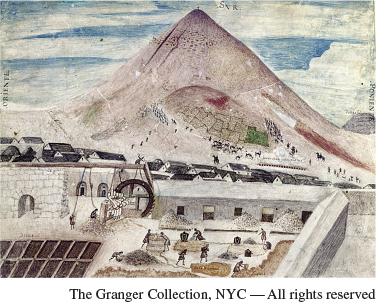ZOOMING IN: Potosí, a Mountain of Silver
615

C hina’s insatiable demand for silver during the early modern period drove global commerce, transforming the economies and societies of far distant lands. Perhaps nowhere did the silver trade have a greater impact than at Cerro de Potosí, a mountain located in a barren and remote stretch of Andean highlands, ten weeks’ travel by mule from Lima, Peru. In 1545, Spanish prospectors discovered the richest deposit of silver in history at Potosí, and within a few decades this single mountain was producing over half of the silver mined in the world each year. At its foot, the city of Potosí grew rapidly. “New people arrive by the hour, attracted by the smell of silver,” commented a Spanish observer in the 1570s. Within just a few decades, Potosí’s population had reached 160,000 people, making it the largest city in the Americas and equivalent in size to London, Amsterdam, or Seville.
The silver was mined and processed at great human and environmental cost. The Spanish authorities forced Native American villages across a wide region of the Andes to supply workers for the mines, with as many as 14,000 to 16,000 at a time laboring in horrendous conditions. A Spanish priest observed, “Once inside, they spend the whole week in there without emerging, working with tallow candles. They are in great danger inside there, for one very small stone that falls injures or kills anyone it strikes. If 20 healthy Indians enter on Monday, half may emerge crippled on Saturday.”15 Work aboveground, often undertaken by slaves of African descent, was also dangerous because extracting silver from the mined ore required mixing it with the toxic metal mercury. Many thousands died. Mortality rates were so high that some families held funeral services for men drafted to work in the mines before they embarked for Potosí. Beyond the human cost, the environment suffered as well when highly intensive mining techniques deforested the region and poisoned and eroded the soil.
Although some indigenous merchants, muleteers, and chiefs were enriched by mining, much of the wealth generated flowed to the Europeans who owned the mines and to the Spanish government, which impounded one-fifth of the silver as well as collecting other taxes and duties. European elites in Potosí lived in luxury, with all the goods of Europe and Asia at their disposal. Merchants brought to Potosí French hats, Venetian glass, German swords, Persian carpets, Southeast Asian spices, and Chinese porcelain and silks. Potosí also imported almost all of its basic needs because the dry, cold region was unable to support the city. Pack trains of llamas brought large quantities of foodstuffs, cloth, and other necessities from Ecuador, Peru, Chile, and Argentina. By the early seventeenth century, the economies of many regions in Spanish South America were structured to supply this huge mining operation.
While the mines caused much suffering, the silver-fueled economy of Potosí also offered opportunity to groups beyond the mine-owning European elite, not least to women. To earn a few pesos for the household, Spanish women might rent out buildings they owned for commercial purposes or send their slaves into the streets as small-scale traders. Less well-to-do Spanish women often ran stores, pawnshops, bakeries, and taverns. Indian and mestiza women likewise opened businesses that provided the city with beverages, food, clothing, and credit. The wealth created a hive of commercial activity in this otherwise-barren backwater.
But the silver that created Potosí also caused its decline. After a century of intensive mining, all that remained were lower-quality ores that were difficult to extract from the ground. This led the mines to shut down. By 1800, Potosí, which had once rivaled the largest cities in Europe, was just a shadow of its former self. The history of this remote region of the Andes reminds us of the profound and often-conflicting results of world trade during the early modern period. While many suffered in the hellish conditions of the mines, others grew wealthy off the demand for silver.
Question: What can Potosí tell us about the consequences of global trade in the early modern period?